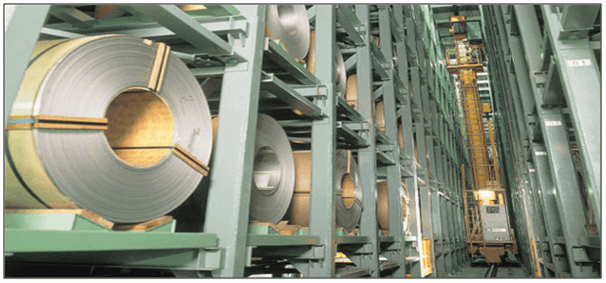There are many ways to manage a machine parts inventory. For example, Sawtooth diagrams, bill of materials, optimal economic order quantity are few methods in inventory control that are familiar and proven. Without these techniques, companies will find it difficult to manage the inventory in huge volumes and cause a delay in shipments. This article discusses several techniques that are essential to manage the machine parts inventory, especially in this competitive market.

Table of Contents
Sawtooth Diagrams
A proven method for maintaining spare parts inventory is to maintain a balanced inventory volume. A sawtooth chart can help examine how it can be reduced or replenished over time. The Y-axis of the chart shows the inventory level. The X-axis shows time. The lines that connect to form a “sawtooth” show the steady decrease in inventory over time. Each peak shows the maximum inventory level. The length between each peak shows the time it will take to deliver. To achieve outstanding forecast, the minimum and maximum inventories for each part must first be known.
Bill of Materials and Economic Order Quantity
It is a formula for making a finished product that is helpful for future use. By keeping BOM up to date to avoid inventory discrepancies and to plan for errors or maintenance. The economic order quantity helps to order and calculate how much inventory to order given a specific production, preferred lead time, and other variables. Therefore, this formula can determine the number of spare parts needed to order or reorder.
Developing a standard workflow process
Manufacturing companies sometimes keep extra parts in one location of a warehouse without bothering to add them to their inventory system. An employee forgets to fill out a form indicating who took the machine parts out for repair, maintenance, or sending to the customer’s location. Discrepancies like this can cause the inventory to be inaccurate. These are few things able to set up in a business. Whoever took the parts is responsible for it. By implementing an automated system to avoid paperwork. Reduce the process to make everyone’s life easier. Give the employee training.

Safe and Motivating Environment
Machine parts are heavy objects. Space and storage play a principal role. Before moving into a place for storage, there are a few important considerations, such as the height of the warehouse, the loading dock, and the location at the exit. Planning is needed for a storage layout and goes to different locations to measure these considerations. If not, the warehouse will be in a big mess and problems will arise.
With these heavy objects, one manpower is not sufficient to carry them. This results in a high turnover rate in the warehouse and fatigues the warehouse worker. Forecast should be done to measure the workload in terms of physical and administrative tasks. Equipment such as a forklift can be used to load and unload the machine part.
It is important to have a toolbox meeting in a warehouse team every morning to ensure compliance with warehouse safety rules and measures. Untrained employees can easily injure themselves. For example, warehouse assistant does not lift a heavy object properly by handling it with a labourer. This leads to damage, injury, and dissatisfaction at work.

Shipping and Packaging
Shipping is one of the inventory techniques that need special attention. The reason for shipping these machine parts. What country and destination require what type of paperwork? Details in the shipping invoice and packing list, the serial number, part number, and weight are crucial details to enter for customs declaration. The price of the parts in USD must be truthfully declared to clear customs. For example, to ship a machine part to a supplier in China. The purpose of the shipment is either a repair or a sample part.
Goods handled by external logistics, freight forwarding, customer, and last-mile partners. In some cases, carton packages do not have enough sustainability to hold the type of product inside the cartons causes them to be easily broken or damaged during the transportation process. These packages could have rubbed against others during their journey, or it could happen when they are in the production line which friction occurred and causing it to damage.
Packaging is crucial to any industry. It protects the package or product from any cause of potential damage. This hazard can occur anywhere from storage in the warehouse to the delivery process. Also, other types of scenarios that can affect the quality of the products must be well considered in the packaging process. Each material used in packaging serves a different purpose. There is a wide range of packaging materials available. The most used ones are cardboard, plastic, wood, metal, aluminum, and paper. For machine parts, make sure that the cardboard can support the heavy load of machine parts. Cut foam and lay it out on the sides and bottom of the box. Wrap the machine parts in shrink wrap and place them in the box. When the courier is handling the cargo, covering the unused space of the box with plenty of foam can ensure that the machine part does not hit against the surface of it and cause damages.
The full content is only visible to SIPMM members
Already a member? Please Login to continue reading.
References
Abby Jenkins. (2020). “Inventory Forecasting: Types, Best Practices, and Benefits”. Retrieved from “https://www.netsuite.com/portal/resource/articles/inventory-management/inventory-forecasting.shtml”, accessed on 21/3/2021.
Lawrence Ho Mun Yong, DLSM. (2020). “Packaging Techniques for Outbound Logistics”. Retrieved from SIPMM: https://publication.sipmm.edu.sg/packaging-techniques-outbound-logistics/, accessed on 21/3/2021.
Michael Mendoza. (2020). “9 Tips for Managing and Optimizing Spare Parts Inventory” Retrieved from “https://global.hitachi-solutions.com/blog/spare-parts-inventory-management”,accessed on 21/3/2021.
Nur Afiqah Bte Ismathas, DPSM. (2020). “Common Techniques for Planning and Controlling Inventory”. Retrieved from SIPMM: https://publication.sipmm.edu.sg/common-techniques-planning-controlling-inventory/, accessed on 21/3/2021.
Sunil Hegde, DLSM. (2020). “Six Inventory Control Techniques for the Printing Industry”. Retrieved from SIPMM: https://publication.sipmm.edu.sg/six-inventory-control-techniques-printing-industry/, accessed on 21/3/2021.



